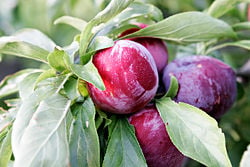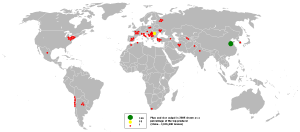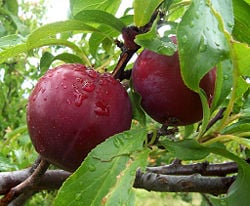Plum
| Plum | ||||||||||||||||
|---|---|---|---|---|---|---|---|---|---|---|---|---|---|---|---|---|
 Plums
| ||||||||||||||||
| Scientific classification | ||||||||||||||||
| ||||||||||||||||
|
See text. |
Plum is the common name for various trees or shrubs with smooth-skinned stone fruit in the genus Prunus of the rose family (Rosaceae), and specifically those plants comprising the subgenus Prunus with the apricot (P. armeniaca). Plums are characterized by shoots with a terminal bud and solitary (not clustered) side buds, and by a fruit with a fleshy edible outer part with a groove on one side enclosing a smooth shell (stone) that encloses a seed. The word plum also is used for this fruit (a drupe). Furthermore, the term plum sometimes is used as a general term for any of the species of the genus Prunus, a taxonomic group that also includes peaches, cherries, and bird cherries.
Description
Prunus is a genus of plant in the family Rosaceae. Rosaceae is one of the largest families of flowering plants with about 3,400 species, including apples, berries, peaches, plums, cherries, the hawthorn tree, the mountain ash, and many others. The genus Prunus includes the plums, cherries, peaches, apricots, and almonds. There are around 430 species of Prunus spread throughout the northern temperate regions of the globe.
The Prunus subgenus, which includes the apricots and plums, is distinguished from other subgenera (peaches, cherries, bird cherries, etc.) in the shoots having a terminal bud and the side buds being solitary (not clustered), the flowers being grouped one to five together on short stems, and the fruit having a groove running down one side, and a smooth stone.
In botany, a drupe is a fruit in which an outer fleshy part (exocarp, or skin; and mesocarp, or flesh) surrounds a shell (the pit or stone) of hardened endocarp with a seed inside. These fruits develop from a single carpel, and mostly from flowers with superior ovaries. The definitive characteristic of a drupe is that the hard, lignified stone (or pit) is derived from the ovary wall of the flower.
Other fleshy fruits may have a stony enclosure that comes from the seed coat surrounding the seed. These fruits are not drupes.
Some flowering plants that produce drupes are coffee, jujube, mango, olive, most palms (including date, coconut and oil palms), pistachio and all members of the genus Prunus, including the almond (in which the mesocarp is somewhat leathery), apricot, cherry, nectarine, peach, and plum.
The term stone fruit (also stonefruit[1]) can be a synonym for "drupe" or, more typically, it can mean just the fruit of the Prunus genus.
Species
The subgenus is divided into three sections:
- Sect. Prunus (Old World plums). Leaves in bud rolled inwards; flowers 1-3 together; fruit smooth, often wax-bloomed.
- P. cerasifera (cherry plum)
- Prunus cocomilia
- Prunus consociiflora"
- P. domestica (species of most "plums" and "prunes" sold as such)
- P. insititia
- P. salicina (Japanese plum)
- P. simonii
- P. spinosa (blackthorn or sloe)
- Sect. Prunocerasus (New World plums). Leaves in bud folded inwards; flowers 3-5 together; fruit smooth, often wax-bloomed.
- P. alleghaniensis
- P. americana
- P. angustifolia
- P. hortulana
- P. maritima (beach plum)
- P. mexicana
- P. nigra
- P. orthosepala
- P. subcordata (Klamath, Oregon, or Sierra plum)
- Sect. Armeniaca (Apricots). Leaves in bud rolled inwards; flowers very short-stalked; fruit velvety. Treated as a distinct subgenus by some authors.
- P. armeniaca (apricot)
- P. brigantina
- P. mume (ume)
- P. sibirica
Cultivation and uses
| Plums (without pit) Nutritional value per 100 g | ||||||||||
|---|---|---|---|---|---|---|---|---|---|---|
| Energy 50 kcal 190 kJ | ||||||||||
| ||||||||||
| Percentages are relative to US recommendations for adults. Source: USDA Nutrient database | ||||||||||
Plum fruit is sweet and juicy and it can be eaten fresh or used in jam-making or other recipes. Plum juice can be fermented into plum wine; when distilled, this produces a brandy known in Eastern Europe as Slivovitz, Rakia, Tzuica or Palinka. Dried plums are known as prunes. Prunes are also sweet and juicy and contain several antioxidants.
Prune marketers in the United States have, in recent years, begun marketing their product as "dried plums", because "prune" has negative connotations connected with elderly people suffering from constipation.
Various flavours of dried plum are available at Chinese grocers and specialty stores worldwide. They tend to be much drier than the standard prune. Cream, Ginsing, Spicy, and Salty are among the common variety flavours. Licorice is generally used to intensify the flavour of these plums and is used to make salty plum drinks and toppings for Shaved Ice or baobing.
Pickled plums are another type of preserve available in Asia and international specialty stores. The Japanese variety, called umeboshi, is often used for rice balls, called "Onigiri" or "Omusubi". The ume, from which umeboshi are made, is however more closely related to the apricot than to the plum.
Prune kernel oil is made from the fleshy inner part of the pit of the plum.
Plums come in a wide variety of colours and sizes. Some are much firmer-fleshed than others and some have yellow, white, green or red flesh, with equally varying skin colour.
Plums and prunes are known for their laxative effect. This effect has been attributed to various compounds present in the fruits, such as dietary fiber, sorbitol,[1] and isatin.[2] Prunes and prune juice are often used to help regulate the functioning of the digestive system.
Plum cultivars in use today include:
- Damson, or Damask Plum
- Greengage, or greengage plum (firm, green flesh and skin even when ripe)
- Mirabelle (a dark yellow plum predominantly grown in northeast France)
- Satsuma plum (firm red flesh with a red skin)
- Golden or yellowgage plum (like the greengage, but yellow)
When it flowers in the early spring, a plum tree will be covered in blossom, and in a good year approximately 50% of the flowers will be pollinated and become plums. Flowering starts after 80 growing degree days.
If the weather is too dry the plums will not develop past a certain stage, but will fall from the tree while still tiny green buds, and if it is unseasonably wet or if the plums are not harvested as soon as they are ripe, the fruit may develop a fungal condition called brown rot. Brown rot is not toxic, and very small affected areas can be cut out of the fruit, but unless the rot is caught immediately the fruit will no longer be edible. Plum is used as a food plant by the larvae of some Lepidoptera including November Moth, Willow Beauty and Short-cloaked Moth.
The plum (Serbian: шљива / šljiva) and the alcoholic drink slivovitz (Serbian: шљивовица / šljivovica) are both very popular in Serbia, where plum production averages 424,300 tonnes per year; FAO 1991–2001.
A large number of plums are also grown in Hungary where they are called szilva and are used to make lekvar, a plum paste jam, palinka a slivovitz-type liquor, plum dumplings, and other foods. The region which produces the best and most plums is Szabolcs-Szatmár in the northeastern part of the country near the borders with Ukraine and Romania.
The mei blossom (Prunus mume), along with the peony, are considered traditional floral emblems of China. On June 21 1964, the Executive Yuan of the Republic of China officially designated the mei blossom to be its national flower, with the triple grouping of stamens (one long and two short) representing the Three Principles of the People and the five petals symbolizing the five branches of the ROC government [2]. The designation, repeats a previous statement by the ROC government in 1929 [3].
In Taiwan the plum has been increasingly used as the national emblem of the Republic of China, as the 12-ray sun originated from the Kuomintang party flag.
The mei blossom is also the floral symbol of the ancient Chinese city Nanjing, which served as the former capital (and remained designated as the official capital) of the Republic of China.
Etymology
The fruit Prunus armeniaca gained its name from the beliefs of Pliny the Elder, a Roman historian and scientist of the 1st century, who maintained that the apricot was a kind of a plum, and had originally come from Armenia.[3] Armenian sources support their claims by referring to a 6,000-year-old apricot pit found in an archaeological site near Yerevan.[3] Other historians point that Mesopotamia as a clue to the Latin name. Apricots were cultivated in Mesopotamia, and it was known as armanu in the Akkadian language.
"Golden Drop" (yellowgage)Plum from Iran
ReferencesISBN links support NWE through referral fees
- ↑ M. Roach, The power of prunes (1999)
- ↑ Innvista article on plums
- ↑ 3.0 3.1 Armenian Food: Fact, Fiction & Folklore By Irina Petrosian, David Underwood
See also
- Fruit trees
- Fruit tree forms
- Fruit tree propagation
- Pruning fruit trees
- Pluot
- Prune (fruit)
- Dietary fiber
External links
Credits
New World Encyclopedia writers and editors rewrote and completed the Wikipedia article in accordance with New World Encyclopedia standards. This article abides by terms of the Creative Commons CC-by-sa 3.0 License (CC-by-sa), which may be used and disseminated with proper attribution. Credit is due under the terms of this license that can reference both the New World Encyclopedia contributors and the selfless volunteer contributors of the Wikimedia Foundation. To cite this article click here for a list of acceptable citing formats.The history of earlier contributions by wikipedians is accessible to researchers here:
The history of this article since it was imported to New World Encyclopedia:
Note: Some restrictions may apply to use of individual images which are separately licensed.

















